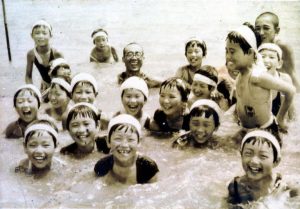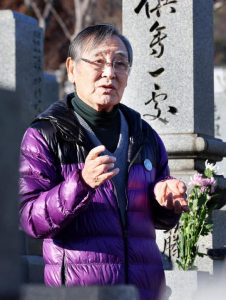Hiroshima’s Tsuyoshi Fujimoto “reunites” with smile of older sister killed in A-bombing thanks to photo in Chugoku Shimbun — Prompts his anti-war feelings
Dec. 30, 2023
by Michiko Tanaka, Senior Staff Writer
Tsuyoshi Fujimoto, 82, an A-bomb survivor who lives in Hiroshima’s Naka Ward, finally got hold of a photograph of his older sister, Takako Fujimoto, who was killed in the atomic bombing at age 12 in the summer of 1945. Right before the summit meeting of the G7 (Group of Seven industrialized nations), held earlier this year in May, he discovered a photo showing his still-alive older sister that was carried on a special cover of the Chugoku Shimbun newspaper and asked the owner if he could have the photo. Her beaming smile captured on film continues to reinforce Mr. Fujimoto’s anti-war feelings.
At the time of the atomic bombing, Takako was a first-year student at First Municipal Girls’ High School (present-day Funairi High School). She had been mobilized to help in the work of demolishing buildings to create firebreaks in case of air raids. She was working just south of what is now Peace Memorial Park. Including Takako, 541 first- and second-year students of the school working similarly were killed.
On May 17, in an effort to communicate the tragedy of the atomic bombing, the Chugoku Shimbun created a special cover for its morning edition, using 12 photos of children taken before their deaths in the bombing. Mr. Fujimoto spotted his older sister in one of the photos, in which Michiko Okata, then 12 and a first-year student at the school, was playing in the water with other girls of around the same age. “I uttered the words, ‘Oh, Taka-chan.’ The girl in the photo looked just like my younger sister born after the war,” he explained. He became more convinced after he had his brother, six years his senior, take a look at the photo.
On August 6, 1945, Mr. Fujimoto and his parents experienced the flash from the atomic bombing at their home in the area of Dote-machi (now part of Minami Ward). Around noon on August 7, Takako made it back on her own to the burned ruins of their house. Despite having only minor burns, she was admitted to a medical facility in what is now Otake City. To her mother who had accompanied her, she explained that she and her teachers and classmates had been in the river but that all the others had died that morning. Takako expressed what seemed to be her chagrin at being the only survivor. Takako grew weaker and, before dawn on August 10, died.
Mr. Fujimoto remembers his older sister wearing a white kimono in a casket before she was cremated at the location where their home once stood. After the war ended, however, his family received “remains” that her school maintained were Takako’s. “My mother just accepted them,” said Mr. Fujimoto. The ashes were placed in their family grave. “My mother probably thought my older sister wouldn’t be as lonely if she was with a friend.”
Mr. Fujimoto had seen only one photo of his older sister taken when she was a young child. In the recent photo, Takako had grown and was playing innocently. Looking at her, he emphasized, “She never would have believed her life would be taken so cruelly. War is absolutely wrong.” Michiko Okata’s younger brother, Kozo Okata, 86, who lives in Hiroshima’s Naka Ward, willingly provided the photo. Mr. Okata said, “The remains of my sister were never found. Such a weapon must never be used again.”
(Originally published on December 30, 2023)
Tsuyoshi Fujimoto, 82, an A-bomb survivor who lives in Hiroshima’s Naka Ward, finally got hold of a photograph of his older sister, Takako Fujimoto, who was killed in the atomic bombing at age 12 in the summer of 1945. Right before the summit meeting of the G7 (Group of Seven industrialized nations), held earlier this year in May, he discovered a photo showing his still-alive older sister that was carried on a special cover of the Chugoku Shimbun newspaper and asked the owner if he could have the photo. Her beaming smile captured on film continues to reinforce Mr. Fujimoto’s anti-war feelings.
At the time of the atomic bombing, Takako was a first-year student at First Municipal Girls’ High School (present-day Funairi High School). She had been mobilized to help in the work of demolishing buildings to create firebreaks in case of air raids. She was working just south of what is now Peace Memorial Park. Including Takako, 541 first- and second-year students of the school working similarly were killed.
On May 17, in an effort to communicate the tragedy of the atomic bombing, the Chugoku Shimbun created a special cover for its morning edition, using 12 photos of children taken before their deaths in the bombing. Mr. Fujimoto spotted his older sister in one of the photos, in which Michiko Okata, then 12 and a first-year student at the school, was playing in the water with other girls of around the same age. “I uttered the words, ‘Oh, Taka-chan.’ The girl in the photo looked just like my younger sister born after the war,” he explained. He became more convinced after he had his brother, six years his senior, take a look at the photo.
On August 6, 1945, Mr. Fujimoto and his parents experienced the flash from the atomic bombing at their home in the area of Dote-machi (now part of Minami Ward). Around noon on August 7, Takako made it back on her own to the burned ruins of their house. Despite having only minor burns, she was admitted to a medical facility in what is now Otake City. To her mother who had accompanied her, she explained that she and her teachers and classmates had been in the river but that all the others had died that morning. Takako expressed what seemed to be her chagrin at being the only survivor. Takako grew weaker and, before dawn on August 10, died.
Mr. Fujimoto remembers his older sister wearing a white kimono in a casket before she was cremated at the location where their home once stood. After the war ended, however, his family received “remains” that her school maintained were Takako’s. “My mother just accepted them,” said Mr. Fujimoto. The ashes were placed in their family grave. “My mother probably thought my older sister wouldn’t be as lonely if she was with a friend.”
Mr. Fujimoto had seen only one photo of his older sister taken when she was a young child. In the recent photo, Takako had grown and was playing innocently. Looking at her, he emphasized, “She never would have believed her life would be taken so cruelly. War is absolutely wrong.” Michiko Okata’s younger brother, Kozo Okata, 86, who lives in Hiroshima’s Naka Ward, willingly provided the photo. Mr. Okata said, “The remains of my sister were never found. Such a weapon must never be used again.”
(Originally published on December 30, 2023)









